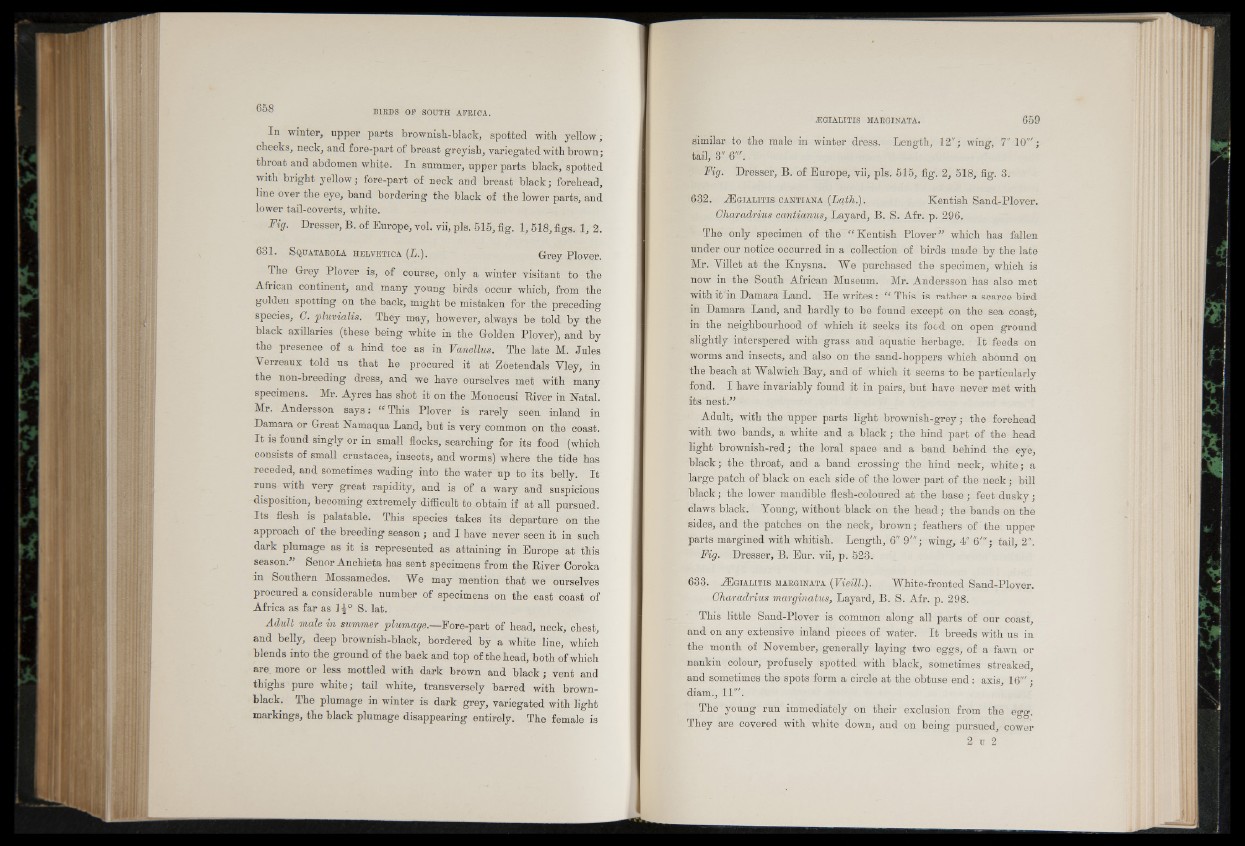
In winter, upper parts brownish-black, spotted with yellow,
cheeks, neck, and fore-part of breast greyish, variegated with brown;
throat and abdomen white. In summer, upper parts black, spotted
with bright yellow; fore-part of neck and breast black; forehead,
line over the eye, band bordering the black of the lower parts, and
lower tail-coverts, white.
Fig. Dresser, B. of Europe, vol. vii, pis. 515, fig. 1,518, figs. 1, 2.
681. S quatarola Helve tica (L.). Grey Plover.
The Grey Plover is, of course, only a winter visitant to the
African continent, and many young birds occur which, from the
golden spotting on the back, might be mistaken for the preceding
species, G. pluvialis. They may, however, always be told by the
black axillaries (these being white in the Golden Plover), and by
the presence of a hind toe as in Vanellus. The late M. Jules
Verreaux told us that he procured it at Zoetendals Yley, in
the non-breeding dress, and we have ourselves met with many
specimens. Mr. Ayres has shot it on the Monocusi River in Natal.
Mr. Andersson says: “ This Plover is rarely seen inland in
Damara or Great Namaqua Land, but is very common on the coast.
It is found singly or in small flocks, searching for its food (which
consists of small Crustacea, insects, and worms) where the tide has
receded, and sometimes wading into the water up to its belly. It
runs with very great rapidity, and is of a wary and suspicious
disposition, becoming extremely difl5.cult to obtain if at all pursued.
Its flesh is palatable. This species takes its departure on the
approach of the breeding season ; and 1 have never seen it in such
dark plumage as it is represented as attaining in Europe at this
season.” Senor Anchieta has sent specimens from the River Ooroka
in Southern Mossamedes. We may mention that we ourselves
procured a considerable number of specimens on the east coast of
Africa as far as 1 S. lat.
Adult male in summer plumage.—Fore-part of head, neck, chest,
and belly, deep brownish-black, bordered by a white line, which
blends into the ground of the back and top of the head, both of which
are. more or less mottled with dark brown and black; vent and
thighs pure white; tail white, transversely barred with brown-
black. The plumage in winter is dark grey, variegated with light
markings, the black plumage disappearing entirely. The female is
similar- to the male in winter dress. Length, 12''; wing, 7" 10'";
tail, 3'' 6"V
Fig. Dresser, B. of Europe, vii, pis. 515, fig. 2, 518, fig. 3.
632. HUg ia l it is cantiana {Lath.). Kentish Sand-Plover.
Gharadrius cantianus, Layard, B. S. Afr. p. 296.
The only specimen of the “ Kentish Plover” which has fallen
under our notice occurred in a collection of birds made by the late
Mr. Villet at the Knysna. We purchased the specimen, which is
now in the South African Museum. Mr. Andersson has also met
with it'in Damara Land. He writes : “ This is rather a scarce bird
in Damara Land, and hardly to be found except on the sea coast,
in the neighbourhood of which it seeks its food on open ground
slightly interspered with grass and aquatic herbage. I t feeds on
worms and insects, and also on the sand-hoppers which abound on
the beach at Walwich Bay, and of which it seems to be particularly
fond. I have invariably found it in pairs, but have never met with
its nest.”
Adult, with the upper parts light brownish-grey; the forehead
with two bands, a white and a black; the hind part of the head
light brownish-red; the loral space and a band behind the eye,
black; the throat, and a band crossing the hind neck, white; a
large patch of black on each side of the lower part of the neck; bill
black; the lower mandible flesh-coloured at the base; feet dusky;
claws black. Young, without black on the head; the bands on the
sides, and the patches on the neck, brown; feathers of the upper
parts margined with whitish. Length, 6" 9"'; wing, 4" 6"'; tail, 2".
Fig. Dresser, B. Eur. vii, p. 523.
633. -¿Egtalitis marginata (Vieill). White-fronted Sand-Plover.
Gharadrius marginatus, Layard, B. S. Afr. p. 298.
This little Sand-Plover is common along all parts of our coast,
and on any extensive inland pieces of water. It breeds with us in
the month of November, generally laying two eggs, of a fawn or
■nankin colour, profusely spotted with black, sometimes streaked,
and sometimes the spots form a circle at the obtuse end: axis, 16'" •
diam., 11'".
The young run immediately on their exclusion from the ee-e- . • 8 5 ' They are covered with white down, and on being pursued^ cower
2 u 2